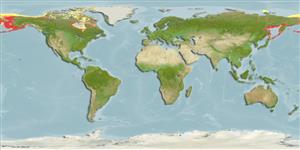Environment: milieu / climate zone / depth range / distribution range
বাস্তুসংস্থান
সামুদ্রিক তলদেশ বিহারী; গভীরতার পরিসীমা 0 - 100 m (Ref. 50550), usually 10 - 70 m (Ref. 56527). Temperate; 88°N - 40°N, 135°E - 60°W
North Pacific: Hokkaido, Japan and Sea of Okhotsk to the Bering Sea. Arctic Canada.
আকৃতি / ওজন / Age
Maturity: Lm ? range ? - ? cm
Max length : 112 cm TL পুরুষ/ লিঙ্গ অনিধর্ারিত ; (Ref. 56527)
পৃষ্ঠীয় কাঁটা (মোট ): 83 - 88; পায়ূ কাঁটা 0; পায়ূর নরম পাখনা্তুন্ড: 53 - 54. Four pairs of strong canines on anterior parts of both jaws; molar teeth on prevomerine and palatal bones and posterior part of lower jaw. Dorsal fin without soft rays. Pelvic fins absent.
Found on rocky bottoms (Ref. 559). Benthic (Ref. 58426). Feeds on hard-shelled invertebrates (Ref. 28499).
Life cycle and mating behavior
পরিপক্কতা | প্রজনন | ডিম ছাড়া | ডিমসমূহ | ডিম্বধারন ক্ষমতা | শুককীট
Eggs are very large.
Masuda, H., K. Amaoka, C. Araga, T. Uyeno and T. Yoshino, 1984. The fishes of the Japanese Archipelago. Vol. 1. Tokai University Press, Tokyo, Japan. 437 p. (text). (Ref. 559)
IUCN Red List Status (Ref. 130435)
Threat to humans
Harmless
Human uses
আরো তথ্য
সূত্র সংখ্যা এ্যাকুয়াকালচার (জলজ পালন) এ্যাকুয়াকালচার নকশা বংশ বংশানুগতিবিদ্যাElectrophoresesউতরাধিকার সুত্রে পাওয়া যোগ্যতারোগ প্রক্রিয়াজাতকরণ NutrientsMass conversion
সহযোগী ছবি সমূহStamps, Coins Misc.শব্দ ক্রোমোজোমের ধরণ গতি সাতাঁরের কায়দা ফুলকা এলাকাOtolithsমস্তিস্ক সমূহদৃষ্টি
হাতিয়ার
Special reports
Download XML
ইন্টারনেট সুত্র
Estimates based on models
Preferred temperature (Ref.
123201): -0.6 - 6.9, mean 2.3 °C (based on 1276 cells).
Phylogenetic diversity index (Ref.
82804): PD
50 = 0.5938 [Uniqueness, from 0.5 = low to 2.0 = high].
Bayesian length-weight: a=0.00398 (0.00174 - 0.00913), b=3.17 (2.97 - 3.37), in cm total length, based on LWR estimates for this (Sub)family-body shape (Ref.
93245).
ট্রফিক পর্যায়ে (Ref.
69278): 3.8 ±0.4 se; based on diet studies.
স্থিতিস্থাপক (Ref.
120179): নিম্ন/ , সর্বনিম্ন প্রজন দ্বিগুনের সময় ৪.৪-১৪ বৎসর (Assuming tm>5).
Fishing Vulnerability (Ref.
59153): High to very high vulnerability (67 of 100).
